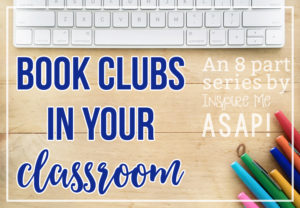
This is my fifth post in my eight post series about implementing book clubs into your classroom. Last week, I wrote about the implementing book club expectations, which you can read more about HERE. Today, I am writing specifically about accountability with book club members.

In talking with other teachers, one of the main concerns they have with implementing book clubs is how to keep students accountable. A teacher emailed me, “How do you make sure they do their assigned reading and writing? How are students held accountable for their participation and work in book clubs?”
Prior to their book club meeting, students are required to prepare by writing about their assigned reading in their book club booklets. Some teachers call them journals, reading response journals, notebooks, ect. I call them book club booklets because we also have reading notebooks/journals as part of our novels during reading workshop. I don’t want my students to get confused, so that term works for us.
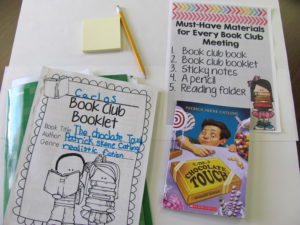
To prepare for their book club meeting, students write in their book club booklet a detailed response about what they read. (Remember, book club meetings are focused on the discussion of the book, not actually reading the book together.) Students respond to what they read by using sticky notes to jot down notes as they are independently reading the book. Students write about what they are thinking about what they are reading, such as “I think Charlie is bored because he is the only child.” Other examples include, “I feel sad for Charlie and his family” and “I‘m wondering why grandpa Joe would gamble?”
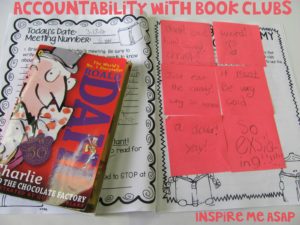
Students are encouraged to write at least three sticky notes prior to every meeting. Each sticky note is placed on the pages as the student reads.
After the meeting is over, the student transfers their sticky note from the pages in their book to their “thinking about reading” page in their book club booklet. I am then able to read and review their writing, which will help guide me in what I need to help each student with.
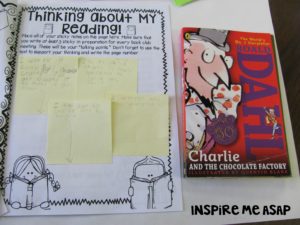
When we first start book clubs, my students have a hard time writing about BIG ideas in the text. I teach and guide my students to produce thoughtful and insightful reflections. I find it is essential to teach several mini-lessons during my reading workshop block about how to write insight reflections that either quote the text or provide textual evidence. This is not an easy task and it takes time to develop this skill! With time you will find that your students will transform their reflections from “That is cool!” with a smiley face, to “On page 58, Opal meets Gloria Dump for the first time. I wonder if Gloria Dump will be one of her friends? This could be an example of foreshadowing .”
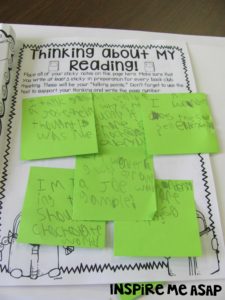
As I mentioned earlier, after the group meeting, the students stick their reflections on their “thinking about my reading” page in their book club booklet. They also take about 5 minutes to independently write a brief summary of how their meeting went. On the left hand side of their book club booklet, they write the date of the meeting, the meeting number, and a brief summary about the meeting, and anything I need to know about. Students are encouraged to write about any successes or struggles that happened that day. Students also include any absent group members and the page they are reading up to for their next group meeting.
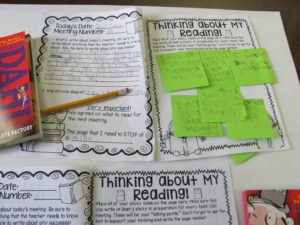
The first few times we do this, my students write about insignificant details. I have to explicitly teach my students to how to write a meaningful summary about their meeting.
Another strategy I use to help keep my students accountable is to encourage them to use agendas.
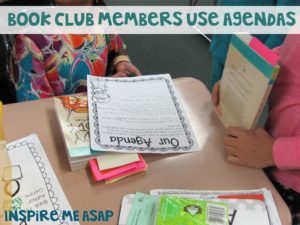
I introduce agendas by showing them a (gasp!) REAL agenda from one of our staff meetings or professional development meetings. I not only show an example of a real agenda and explain what they are, but I also make sure to highlight the importance of using an agenda for group meetings. They think that it is the coolest thing EVER to have the opportunity to create and use their own agenda, just like teachers do!
After explicit teaching how to effectively use an agenda, book club groups are encouraged to write their own agenda. The agenda could be for one group meeting or it could be for the entire week. Although my students create most of the items on their agendas, I also will add a task if I feel it is necessary for that particular group.
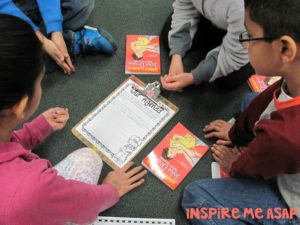
Last but not least, another strategy that I use to hold my students accountable is the book club expectations. I wrote in-depth about setting expectations HERE. Book clubs are all about the STUDENTS taking ownership over their books, discussions, and meetings. As a result, the students actually hold each other accountable. Students do not want to disappoint their group members. They do not want a consequence for not completing their assigned reading or writing.

I hope that helps give you some ideas about how to help keep your students accountable during book clubs. I want to wrap up this post posting some questions that I got from some other teachers. I hope that my response can clear up any confusion you might have regarding the same questions.
Teacher Questions are in Bold:
I have a few questions. First question, when do the kids meet for book clubs? Is it every day or a few times a week?
I use a reading workshop model to teach reading. When I implement book clubs with my third graders, I teach an entire unit specifically on book clubs. My reading workshop mini-lessons are all focused a specific skill or strategy that I want my students to demonstrate during book clubs. For example, one mini-lesson might be about using an agenda to guide a meeting. Another mini-lesson might be explicitly teaching my students how to read an assigned portion of text and take specific, insightful notes about what they read.
I was looking at your book club product on your blog and tpt. Are those mini lessons on the days the book clubs meet?
There are 15 mini-lessons that are included in this file, which focus on establishing routines and setting expectations for book clubs with your students. They are listed below. Yes, ideally these mini-lessons would be taught right before each group meets. Some of the mini-lessons just ask that the students touch base with each other for 5 to 7 minutes and it is a very brief meeting. Students will quickly learn that other meetings can last up to twenty minutes, based on the mini-lesson that was taught.
Mini-lessons that I teach to successfully implement book clubs include:
-Define book clubs and understand its importance
-Describe characteristics of what book clubs LOOK like
-Describe characteristics of what book clubs SOUND like
-Book club members are assigned
-Commit to expected behaviors
-Shop for a book
-Follow agendas to stay on task
-Prepare for group meetings
-Read assigned portions of text and take notes about what they read
-Participate in a group discussion
-Share their opinions with group members
-Keep conversations on-task and focused
-Compromise and problem solve when issues arise
-Use prompts to guide their discussions
-Self-reflect and evaluate their performance
All of these mini-lessons are part of my Book Club file. These mini-lessons are detailed lesson plans and include colorful posters for you to print for your anchor charts. It also includes reproducibles for your students.
I guess I’m trying to figure out if your book club time is an extra 30 minutes or so separate from your workshop time, or is it all in one? I know you cover the standards in groups, but do you cover the standards in your mini lesson for workshop or do you cover them after you’ve finished your book club mini lesson?
Great question! Let me see if can explain this in a way that makes sense. :) Here is an example of my reading workshop time:
10:00-10:10 Reading workshop mini-lesson – Students come together on the carpet to meet for the mini-lesson. An example of a mini-lesson might be “book club members compromise and problem solve when issues arise.” The mini-lesson would also be known as the objective or learning target for ELA. This is where I use the CCSS to focus on what my students need to learn and how I will use book clubs as a mean to do so.
10:10-10:30 Book club meetings – Each student participates in a book club. During this time, each group meets to discuss the book they are reading. Each group also makes sure to focus on the strategy or skill taught during the mini-lesson. **Important note: Although I have twenty minutes for this example, there are some days where group meetings go for thirty minutes or some days where group meetings go for 15 minutes. I always tell my students they must meet for a minimum of 15 minutes, which would mean that they effectively discussed all the important items on their agenda.**
During this time, I am actively walking around to meet/visit with groups. (I have a specific blog post coming up for the teacher’s role.)
10:30-11:00 Independent Reading- Students go back to their seats. They take about 5 minutes to reflect about their group meeting in their book club booklets. They transfer their sticky notes from their book to their book club booklet. Students write about successes or areas of what they need to work on in their book club booklets. Then, students begin their assigned reading. If their group agreed to read up to page thirty and read a total of 15 pages, they the students begin to independently read those assigned pages.
During this time, I am meeting with groups students at the reading table. This could mean that I am meeting with guided reading groups, book club groups, or a group of students who all need help with the same skill/strategy. This is also a time where I would differentiate instruction for students/groups, depending on their strengths and weaknesses.
11:00- Closing of Reading Workshop – Students come together on the carpet again. We review the mini-lesson and students turn and talk to share what they did during their independent reading.
Again, this time might need to be adjusted according to the grade you teach and/or your district’s mandates for ELA instruction. My students do not meet with their book club group everyday.
If you are looking for more guidance specifically on reading workshop, click HERE and HERE.
Are your students meeting with book club groups each day? If not, are they reading other books during workshop time (this would mean they are actively reading 2 books at once, just not the same book each day).
Depending on the week, I schedule group meetings two days a week (Tuesday and Thursday) or three days a week (Monday, Wednesday, Friday.) Keep in mind that some groups might need to meet an extra day to “catch up.” This is the beautiful benefit of book clubs- the students truly do take ownership over these important decisions! Yes, you are correct. After my students finished their assigned reading with their book club book, then they resume reading with whatever book is in their book nooks. They could be reading multiple chapter books at the same time.
I would love to hear more about how you meet with groups during reading workshop. Do you interrupt their reading to work with them in small group on skills non related to book club or do you discuss book club reading with them? Once challenge I am battling is getting to each group and each member being at a different spot in their reading when I meet with my 2nd and 3rd groups.
Great question! There two ways you can meet with groups during a book club study. First, you can meet with groups as students are independently reading. You can meet with students in a traditional guided reading group or you could pull a group of students who all need help with the same skill/strategy. For example, if you are noticing a group of 5 students who are having trouble citing textual evidence, that could be the focus for your reading group. These students could use their book club book or a different book that works well with that strategy.
You can also choose to meet with groups during their actual book club meeting. As you are walking around and listening to each group during book club meeting time, you might see that one group in particular needs immediate guidance. You can give them a quick reminder or tip or you can sit on the floor with them and join their group meeting. It might be planned based on what you saw in a previous group meeting or it could spontaneous and based on what you just saw/heard. Either way, the CCSS would guide your instruction and book clubs would be a way to incorporate those ELA and Speaking and Listening standards.
The difficulty of book clubs is the management of groups and where they are at in the text. However, that is exactly what book clubs are all about! The beauty of book clubs is that they are naturally differentiated instruction because each group has a different book and are working at their own pace/level. Book clubs encourage students to choose their own text, create their agenda, and have meaningful discussions. Book clubs are challenging and each child responds with a safe level of academic frustration, which only creates growth in their skill set. If you are noticing that each group is at a working on different point with different books, that is a wonderful observation to celebrate because it is the heart of authentically implementing book clubs.
I don’t think you need to feel the pressure that you *must* meet with each group in a formal reading group during each meeting. That would make our job so stressful and take the joy out of book clubs. Instead, focus on one target skill. Go back to the mini-lesson. What did you teach during your whole-group mini-lesson? Was the focus on textual evidence, identifying character traits or the theme? This is what I keep in mind as I meet with every group briefly during their meetings. Everything that happens in the text is not significant. As the teacher, I guide my students to help determine the most important events and discuss those in depth. The best advice I can give is to focus one specific, meaningful target skill for each group. I hope that helps!!! :)
What questions do you have about book clubs? I would love to hear from you! Feel free to email me or write a comment with your question. I will address all questions throughout my blog post series on book clubs. My next blog post will be about student-led conversations in book clubs.

Chapter One: Introduction to book clubs
Chapter Two: Benefits of book clubs
Chapter Three: Matching books to readers
Chapter Four: Book club expectations
Chapter Five: Accountability with book club members
Chapter Six: Student-led conversations in book clubs
Chapter Seven: Role of the teacher in book clubs
Chapter Eight: Using assessments in book clubs
Looking for a resource to help you implement book clubs in your classroom?
Check out my resource below:
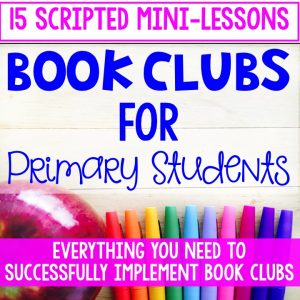
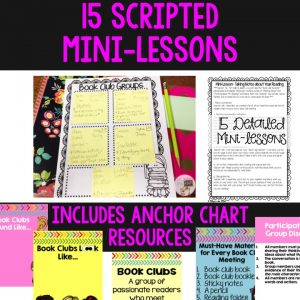
File Description:
Looking for an engaging and sure-fire way to motivate your readers? This 107 page file has everything you need to know in order to effectively implement a book clubs with your rockin’ readers, while meeting the CCSS for Speaking and Listening.
There are 15 mini-lessons that are included in this file, which focus on establishing routines and setting expectations for book clubs with your students.
Mini-lessons include:
Detailed lesson plans
Colorful posters for you to print for your anchor charts
Reproducibles for your students
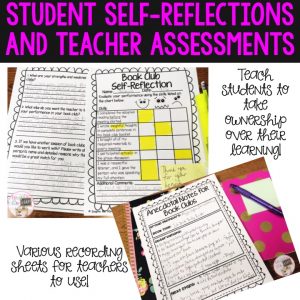
During this unit, readers will learn to:
-Define book clubs and understand its importance
-Describe characteristics of what book clubs LOOK like
-Describe characteristics of what book clubs SOUND like
-Book club members are assigned
-Commit to expected behaviors
-Shop for a book
-Follow agendas to stay on task
-Prepare for group meetings
-Read assigned portions of text and take notes about what they read
-Participate in a group discussion
-Share their opinions with group members
-Keep conversations on-task and focused
-Compromise and problem solve when issues arise
-Use prompts to guide their discussions
-Self-reflect and evaluate their performance
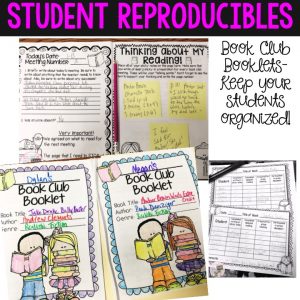
Also included in this unit:
-A note to send home to parents
-Tips for teachers about implementing book clubs successfully
-Detailed rubrics for teachers and students
-Bulletin board resources, where each group can post their group name, picture, assignment, and other important information
This Book Club Resource is also part of my Reading Workshop BUNDLE
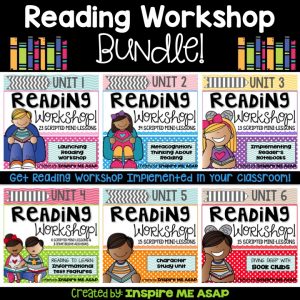
Click HERE to purchase Book Clubs from Teachers Pay Teachers.
Save 10% by purchasing directly from my website.





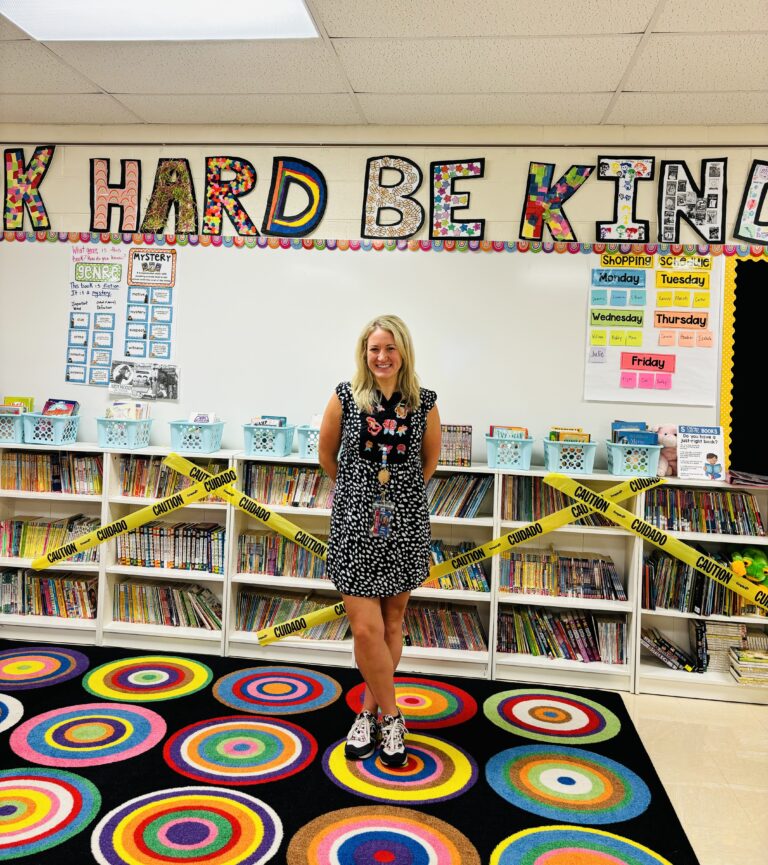



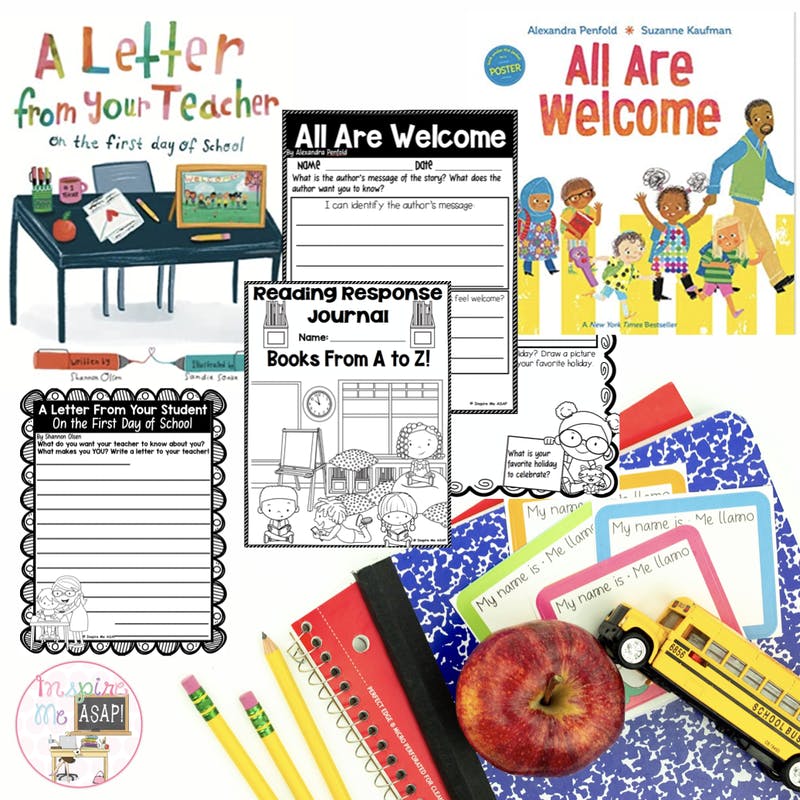
5 Responses
Hey Melissa. What do you do if a student finishes silent reading early and finishes preparing for their meeting early? Can you explain why you have the students read silently on their own rather than in their reading groups? Maybe I will switch that up this year,
Hi Elaine!
Great question. If a student finishes early, they begin to read another book in their book nook. My students keep about 3-4 books in their book nooks at a time. Students benefit from book clubs when they focus on holding rich, authentic discussions about the book, not reading the book together. My students read together when they are practicing their reading fluency, in reading partnerships. However, book clubs have a different focus. I hope that helps!
Where are the rest of the posts??? I am so intrigued and trying to figure out how to implement Book Clubs into my schedule this year.
Hello Jerica,
Thanks for your message! I finished writing 6 blog posts so far on book clubs, with two more to go. You can read all of these posts by clicking on the link where it lists the chapters and the title of each chapter. It is right under the Book Clubs 101 image.
THanks!
Melissa :)
I would love to be able to implement this with my fifth graders. However, I have 120 students (6 sections) with only 45 minutes per section. Could it still be done? Any suggestions would be appreciated! TIA